.
30.01.2015
WHERE IS PHILAE? WHEN WILL IT WAKE UP?
These are the two most popular questions currently being asked of the mission – especially on our social media channels – and ones that we will try to answer in this post, including inputs from the OSIRIS team, and from the Lander Control Centre at the German Aerospace Center (DLR).
Where is Philae?
Ever since Philae touched down on Comet 67P/Churyumov-Gerasimenko for the final time on 12 November – it is thought to have come into contact with the comet’s surface a total of four times including the final landing – the search has been on to identify it in images. While the CONSERT instrument has helped to narrow down a 350 x 30 m ‘landing strip’ on Comet 67P/C-G’s smaller lobe, a dedicated search in OSIRIS images has so far not been able to confirm the little lander’s final location.
-

Philae’s descent to the surface, the initial touchdown at Agilkia at 15:34 UT (onboard spacecraft time) and first rebound were well-documented with the OSIRIS narrow-angle camera. The team also identified what they believe to be the lander in a wide-angle shot taken at 17:18 UT above the rim of the large depression – named Hatmehit – on the comet’s small lobe. The image has been used to guide subsequent lander search efforts, and provides the basis for trajectory reconstructions. According to data recorded by Philae’s ROMAP instrument, the lander may have grazed the surface at 16:20 UT – so this image may have captured the result of that encounter.
-
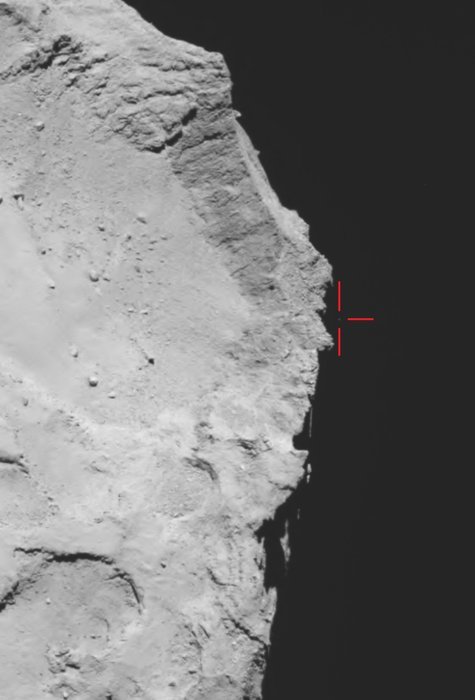
Philae above the comet? Rosetta’s OSIRIS wide-angle camera captured this view of Comet 67P/Churyumov–Gerasimenko on 12 November 2014 at 17:18 GMT (onboard spacecraft time).
Credits: ESA/Rosetta/MPS for OSIRIS Team MPS/UPD/LAM/IAA/SSO/INTA/UPM/DASP/IDA
-
Philae’s onboard data subsequently recorded the next touchdown at 17:25 UT and its final touchdown at 17:32 UT, at a site that has now been named “Abydos” (the first touchdown site remains as Agilkia). Images sent back by the CIVA imager onboard the lander and subsequent reconstructions are providing clues as to the nature of the landing site, but a visual confirmation is still required to confirm its location.
Follow-up dedicated OSIRIS imaging campaigns that took place in late November and December from distances of 30 and 20 km from the centre of the comet (about 28 and 18 km from the surface, respectively) have not been successful in locating the lander. The campaigns specifically targeted the times that the lander would be illuminated – it is illuminated approximately 1.3 hours per comet revolution – and that Rosetta had the correct orbital position to be able to image it. However, the cameras were looking into long cast shadows from Rosetta’s terminator orbit, perpendicular to the Sun direction, which does not provide the optimum conditions for detecting the lander.
It is also important to note that Rosetta’s trajectory immediately following Philae’s touchdown allowed for good viewing conditions at the original landing site. Now that Rosetta has moved to a different orbit, and is further away from the comet, the chances of observing the lander are less (watch this video for a recap of the different trajectories following the landing).
The image below is an example of the images being used to search for the lander; it is a slightly cropped 2 x 2 mosaic taken by the OSIRIS narrow-angle camera on 13 December 2014 from a distance of about 20 km to the centre of the comet. For the 20 km imaging run 18 sets of two images were taken – one each with orange and blue filters to take advantage of the reflection of the lander solar panels, which differ compared to the cometary environment. The images were taken in the 2 x 2 rasters to ensure good surface coverage. The lander, about 1 metre across – the size of a household washing machine – would measure only about three pixels across in these images.
“We’re looking – by eye – for a set of three spots that correspond to the lander,” says OSIRIS principal investigator Holger Sierks from the Max Planck Institute for Solar System Research (MPS) in Germany. “The problem is that sets of three spots are very common all over the comet nucleus; Hatmehit and the area around its rim where we’re looking is full of boulders and we have identified several sets of three spots.”
-

Lander search area. The image is a 2 x 2 mosaic comprising OSIRIS narrow-angle camera images taken on 13 December 2014 from a distance of about 20 km to the centre of the comet. Credits: ESA/Rosetta/MPS for OSIRIS Team MPS/UPD/LAM/IAA/SSO/INTA/UPM/DASP/IDA
Although Rosetta is flying to within 6 km of the comet’s surface on 14 February, the planned trajectory foresees the closest approach on the lower part of the larger comet lobe (although the trajectory also takes Rosetta over the first touchdown point). This trajectory is planned such that the Sun will be directly behind the spacecraft, allowing the acquisition of shadow-free images. The close flyby will also allow the suite of science instruments on the orbiter to take spectra of the surface with unprecedented resolution and to directly sample the very innermost regions of the cometary coma in order to learn more about how the comet’s characteristic coma and tail develop.
“Rosetta’s busy science schedule is planned several months in advance, so a dedicated Philae search campaign was not built into the plan for the close flyby,” says ESA’s Rosetta project scientist Matt Taylor. “We’ll be focusing on “co-riding” observations from now on, that is, we won’t be changing the trajectory of Rosetta to specifically fly over the predicted landing zone in a dedicated search, but we can modify the spacecraft pointing and/or command images to be taken of the region if we’re flying close to the region and the science operations timeline allows.”
“After the flyby we’ll be much further away from the comet again, so are unlikely to have the opportunity for another dedicated lander search until later in the mission, maybe even next year,” adds ESA’s Rosetta mission manager Fred Jansen. “But the location of Philae is not required to be able to operate it, and neither does it need to be awake for us to find it.”
-
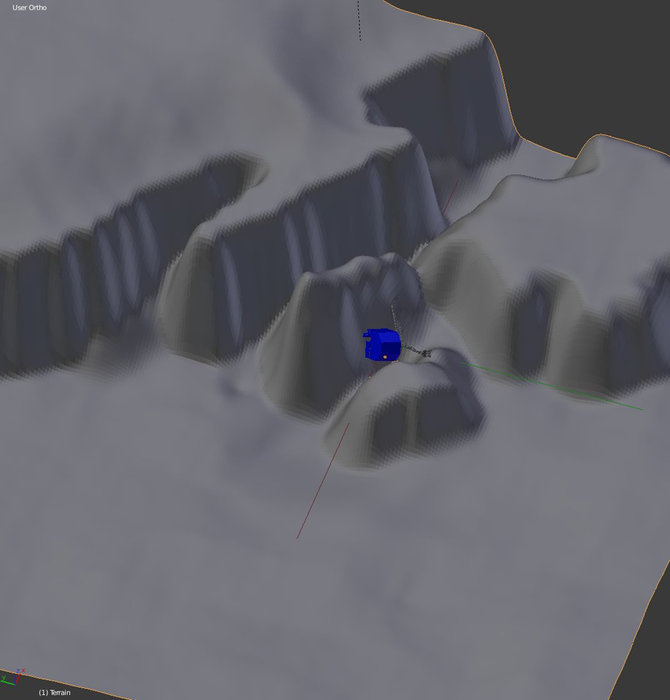
The likely orientation of Philae, shown in a visualisation of a topographic model of the comet's surface. Credits: ESA/Rosetta/Philae/CNES/FD
-
When will Philae wake up?
For those of you who followed the wake-up of Rosetta, you will know that it is not simply a case of switch on and get back to the science right away. The same goes for Philae.
At the original landing site, Philae was expected to receive around 6.5 hours of illumination per 12.4 hour comet day, with temperatures becoming too high by March 2015 to enable continued operations. Now, at its new location, the illumination is just 1.3 hours.
“Now we need the extra solar illumination provided by the comet’s closer proximity to the Sun by that time in order to bring the lander back to life,” says DLR’s Lander Project Manager Stephan Ulamec.
In fact, even by May, the Sun inclination will be such that it will be directly overhead of the predicted landing zone, although the lander’s orientation is such that it won’t be able to make full use of the maximum illumination on offer.
As for the process of wake up, and assuming Philae survived the low temperatures in its new residence, the earliest that the lander team expect it to be warm enough to boot up is in late March. But it will likely be May or June before there is enough solar illumination to use its transmitter, and to re-establish a communications link with Rosetta – the lander needs about 17 Watts to wake up and say “hello”.
Furthermore, the orbiter also has to be commanded to listen for Philae’s “I’m awake” signal, and be in a good position relative to the landing site to pick up the signal – although it can be up to 200 km away from the comet. It will be longer still before the battery is fully charged and Philae is ready to do science again, but that means there is a chance it will have a ringside seat for perihelion.
“We are already discussing and preparing which instruments should be operated for how long,” adds Stephan.
But even if Philae doesn’t wake up, it’s important to remember that it already completed its first science sequence on the comet, unexpectedly providing information from multiple locations on 67P/C-G.
Meanwhile Rosetta will continue to follow the comet on its orbit around the Sun and as it heads back towards the outer Solar System.
Quelle: ESA
-
Update: 2.02.2015
.
MORE CHANGE IN HAPI? – COMETWATCH 22 JANUARY
Today’s CometWatch mosaic comprises images taken by Rosetta’s navigation camera (NAVCAM) on 22 January, from a distance of 28.0 km from the centre of Comet 67P/Churyumov-Gerasimenko. The image resolution is 2.4 m/pixel and the individual 1024 x 1024 frames measure 2.4 km across. The mosaic measures 4 x 4 km.
.
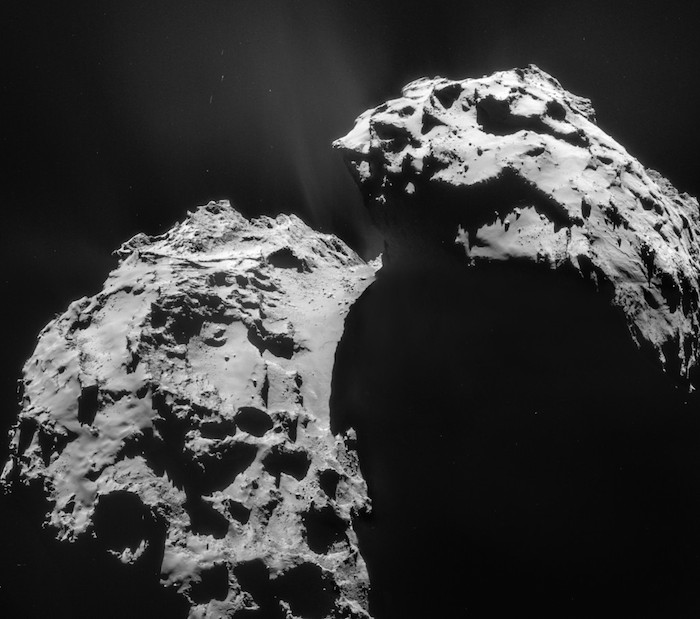
Four image mosaic comprising images taken on 22 January 2015 by Rosetta's Navigation Camera (NAVCAM). Rotation and translation of the comet during the imaging sequence make it difficult to create an accurate mosaic, and there may be some spurious spatial and intensity features as a result of the mosaic-making sequence, so always refer to the individual frames before performing any detailed comparison or drawing conclusions about any strange structures or low intensity extended emission. Credits: ESA/Rosetta/NAVCAM – CC BY-SA IGO 3.0
.
The mosaic looks down onto the Seth region on the larger lobe (left) and its transition into the smooth neck region of Hapi, with the smaller comet lobe to the right – the rim of Hatmehit just visible along the horizon.
One particularly interesting observation is that the curved, horseshoe-shaped markings in Hapi have appeared to change in appearance since the last published images of this region (for example, take a look at the CometWatch entries for 8 January and 9 December).
Of course, we cannot discount the role that the change in viewing geometry/illumination conditions play, but the markings that in today’s image can be seen about a third from the top of the lower left frame, seem a lot more developed than in the 8 January image, where there is perhaps only just a hint of them in the making.
Today’s image also affords a great view of the flat plateau with its thumbprint-like depressions along its edge. As discussed in previous entries, these features are considered possible precursors to fracture or collapse. (Click here for OSIRIS image of this feature.)
We look forward to seeing what other interesting features you spot in today’s image set!
The four frames and a montage of the 1024 x 1024 images are provided below:
.

.

Quelle: ESA
-
BIld des Tages: "Jets vom Kometen Churyumov-Gerasimenko"

Quelle: ESA
-
Update: 4.02.2015
.
LANDER PHILAE: WARTEN AUF EIN LEBENSZEICHEN
Im Lander Control Center des Deutschen Zentrums für Luft- und Raumfahrt (DLR) ist es ruhig - Lander Philae befindet sich auf dem Kometen Tschurjumow-Gerasimenko im Winterschlaf und somit gibt es auch eine Atempause für das Team im Kontrollraum.
Am 15. November 2014 um 1.36 Uhr war Philaes Batterie nach einer dreifachen Landung und mehr als 56 Stunden wissenschaftlicher Arbeit erschöpft. Nun wartet das Team darauf, dass der Lander auf der Kometenreise Richtung Sonne wieder genügend Energie erhält, um sich zurückzumelden. "Die größte Wahrscheinlichkeit besteht im Mai, dass wir in Kontakt mit Philae treten können" sagt Philae-Projektleiter Dr. Stephan Ulamec vom DLR in Köln.
"Wir werden aber bereits ab Ende März versuchen, ob Philae schon ausreichend stark von der Sonne angestrahlt und mit Energie versorgt wird." Auch die Temperaturen an seinem eisigen Standort dürften dann günstiger für Philae werden.
Wo exakt er steht, konnte jedoch noch nicht festgestellt werden: Bisher konnte er auf keinem Bild der OSIRIS-Kamera entdeckt werden. Mit den nun anstehenden Flugmanövern des Rosetta-Orbiters wird dies in nächster Zeit auch kaum noch möglich sein. Nach der Landung ist vor der Landung. Es war eine spektakuläre Landung, die Philae am 12. November 2014 hinlegte:
Pünktlich wie geplant setzte er um 16.34 Uhr mitteleuropäischer Zeit auf dem Kometen auf, nachdem er mit Schrittgeschwindigkeit aus 22 Kilometern Höhe in Richtung Churyumov-Gerasimenko herabgesunken war. Doch die Daten, die im Lander Control Center ankamen, zeigten dem DLR-Team schnell: Philae war schon wieder unterwegs.
"Die Solarpaneele, die an den Außenseiten des Landers sitzen, zeigten in den Energiekurven deutliche Schwankungen - Philae musste sich also noch drehen und konnte nicht fest auf dem Boden stehen", erklärt DLR-Projektleiter Dr. Stephan Ulamec.
Fieberhaft werteten die Wissenschaftler in ihren Teams die frischen Daten unter anderem der Messungen von MUPUS und ROMAP aus und konnten schließlich bestätigen: Lander Philae steht nicht mehr auf der Kometenoberfläche, sondern befindet sich wieder im Flug. In 500 Millionen Kilometer Entfernung von der Erde hatte der Lander seinen sorgfältig ausgewählten Landeplatz Agilkia also nur kurz berührt und dann wieder verlassen.
Schattige Stelle am Kraterrand
Erst um 18.32 Uhr mitteleuropäischer Zeit setzte er nach einer weiteren Zwischenlandung endgültig auf - und steht seitdem schattig und in der Nähe eines Kraterrands auf dem Kopf des Kometen, dicht an der Nähe des Kometen-Äquators. Zumindest einen Namen hat der Standort von Philae mittlerweile erhalten: Die finale Landestelle wurde nach der antiken ägyptischen Stadt Abydos benannt. Die ESA hatte zusammen mit dem DLR, der französischen Raumfahrtagentur CNES und der italienischen Raumfahrtagentur ASI einen internationalen Wettbewerb zur Namensfindung durchgeführt.
Dabei wurde für die ursprüngliche Landestelle vom Lander Steering Committee der Name "Agilkia" ausgewählt. Der Name "Abydos" machte damals nicht das Rennen und kam nur auf den zweiten Rang. Nun, mit einem weiteren, finalen Landeplatz, kommt der Namensvorschlag doch zum Zug. Abydos ist nicht nur als antike Nekropole bekannt, sondern hat mit ungewöhnlich geformten Hieroglyphen auch für unterhaltsame Spekulationen gesorgt: In einer Inschrift sind Hieroglyphen zu sehen, die einem Hubschrauber und einem U-Boot ähneln. Suche nach der Nadel im Heuhaufen.
Mit dem Instrument CONSERT grenzten die Wissenschaftler den finalen Standort von Philae immerhin auf ein Gebiet von etwa 350 mal 30 Metern ein. Die exakte Position konnte jedoch noch nicht ermittelt werden. Auf den Aufnahmen der OSIRIS-Kamera aus 20 und 30 Kilometern Entfernung zeigte sich der Lander nicht.
Vor allem während der Kometentage, während der Lander von der Sonne 1,3 Stunden angestrahlt wurde, richteten die Wissenschaftler ihre Kamera immer wieder auf das Landegebiet aus. Doch der gerade kühlschrankgroße Lander Philae würde nur einen Durchmesser von drei Pixeln auf den Aufnahmen haben - es ist eine Suche nach der Nadel im Heuhaufen. Am 14. Februar 2015 wird sich die Rosetta-Muttersonde zwar in einem Vorbeiflug dem Kometen auf nur noch sechs Kilometer annähern, doch verläuft die Flugbahn über die dem Lander abgewandte Kometenseite.
Auch in Zukunft soll die Flugbahn des Orbiters nicht für die Suche nach Philae abgeändert werden, sondern nur die Ausrichtung der Kamera angepasst werden, wenn das Landegebiet in Sicht ist und die wissenschaftliche Arbeit dies gestattet, sagt Dr. Matt Taylor, Rosetta-Projektwissenschaftler bei der ESA.
Energieschub für die Kommunikation
Die erste Chance auf einen Kontakt mit Philae erwartet das Philae-Team im Lander Control Center nicht vor Ende März: "Der Lander benötigt zusätzliche Energie, die erst durch die Annäherung von Tschurjumow-Gerasimenko an die Sonne entsteht."
Zudem muss in exakt diesem Zeitraum der aus dem ESOC in Darmstadt gesteuerte Rosetta-Orbiter über Abydos fliegen, damit die Kommunikation mit Philae möglich ist. Erst wenn diese Bedingungen gegeben sind, wird am Orbiter die Kommunikationseinheit aktiviert, die mit Philae Kontakt aufnehmen kann. Wird Philae wach, ist er darauf programmiert, in regelmäßigen Abständen nach dem Orbiter zu lauschen und ein Signal zu senden. 17 Watt benötigt das Landegerät dafür, aufzuwachen und ein Lebenszeichen zu funken.
Voraussetzung ist zudem eine Betriebstemperatur der Lander-Elektronik von nicht weniger als minus 40 Grad Celsius. "Wir hoffen, dass Philae bis dahin seinen Winterschlaf bei niedrigen Temperaturen gut übersteht", sagt Projektleiter Dr. Stephan Ulamec.
An seinem ursprünglichen Landeplatz hätte Philae immerhin 6,5 Stunden lang pro Kometentag in Sonnenlicht baden und seine Batterien schneller aufladen können. Allerdings wäre er dann wahrscheinlich auch schon im März überhitzt und hätte somit nicht mehr arbeiten können.
Nun ist die Nähe zur Sonne gut für Philae an seinem schattigen Standort, weil nicht nur die Temperatur betriebsfreundlicher wird, sondern auch die Stärke der Sonnenstrahlung zunimmt und die Solarzellen des Landers mehr Strom generieren.
Aufwachen in mehreren Schritten
Geht Philaes Rückmeldung aus dem All ein, wird das Missionsteam dennoch erst einmal Geduld beweisen müssen:
Es könnte mehrere Wochen dauern, bis der Lander nach dem ersten Aufwachen ausreichend Energie erhält, um nicht nur erste Kommandos auszuführen, sondern auch mit dem Aufladen der Batterie zu beginnen.
Im Sommer hätte er dann voraussichtlich genug Energie gespeichert, um über mehrere Stunden hinweg die Instrumente einzusetzen.
"Wie lange dies möglich sein wird, hängt natürlich auch davon ab, wie energieaufwendig die Experimente sind." Bereits jetzt diskutiert und plant das Lander-Team aus Ingenieuren und Wissenschaftlern, welche Instrumente für welche Messungen eingesetzt werden sollten. "Temperaturmessungen, Fotos oder das Instrument COSAC im Schnüffelmodus verbrauchen wenig Energie, der Einsatz eines Bohrers natürlich deutlich mehr."
Quelle: ESA
--
ROSETTA SWOOPS IN FOR A CLOSE ENCOUNTER
ESA’s Rosetta probe is preparing to make a close encounter with its comet on 14 February, passing just 6 km from the surface.
.
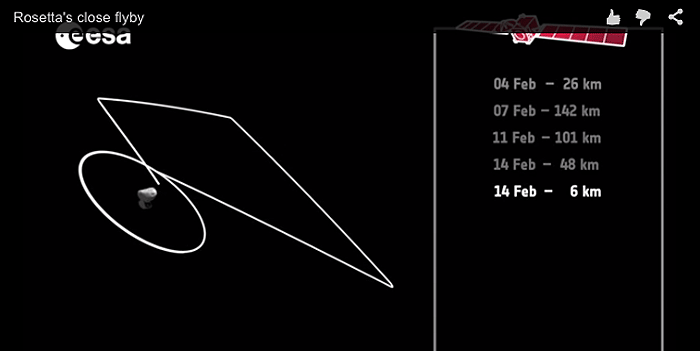
Today, Rosetta is moving into a new path ahead of a very close encounter next week. First, it will move out to a distance of roughly 140 km from the comet by 7 February, before swooping in for the close encounter at 12:41 GMT (13:41 CET) on 14 February. The closest pass occurs over the comet’s larger lobe, above the Imhotep region.
“The upcoming close flyby will allow unique scientific observations, providing us with high-resolution measurements of the surface over a range of wavelengths and giving us the opportunity to sample – taste or sniff – the very innermost parts of the comet’s atmosphere,” says Matt Taylor, ESA’s Rosetta project scientist.
-
AROUND ATEN – COMETWATCH 26 JANUARY
This four-image montage comprises images taken from a distance of 27.7 km from the centre of Comet 67P/Churyumov-Gerasimenko on 26 January. The image resolution is 2.4 m/pixel and the individual 1024 x 1024 frames measure 2.4 km across.
.

Montage of four images of Comet 67P/Churyumov-Gerasimenko taken on 26 January 2015 by Rosetta's Navigation Camera (NAVCAM). Credits: ESA/Rosetta/NAVCAM – CC BY-SA IGO 3.0
Rotation and translation of the comet during the imaging sequence often make it difficult to create accurate mosaics out of the four NAVCAM images. But this time we found it impossible to make one without excessively distorting the comet’s features and thus we’re just posting the montage. The image provides a nice view across the comet's larger lobe (foreground) and up onto the smaller lobe.
The montage is centred on Aten, a region on the larger lobe that extends diagonally from the bottom part of the upper left frame to the top part of the lower right frame, below the prominent cliffs that separate Aten from the brighter Babi region.
In the two lower frames, the Imhotep region on the underside of the larger lobe is cast in shadow. Portions of Babi, Khepry, and Ash are visible on the larger lobe, and parts of Ma'at and Bastet can be seen on the smaller lobe.
.
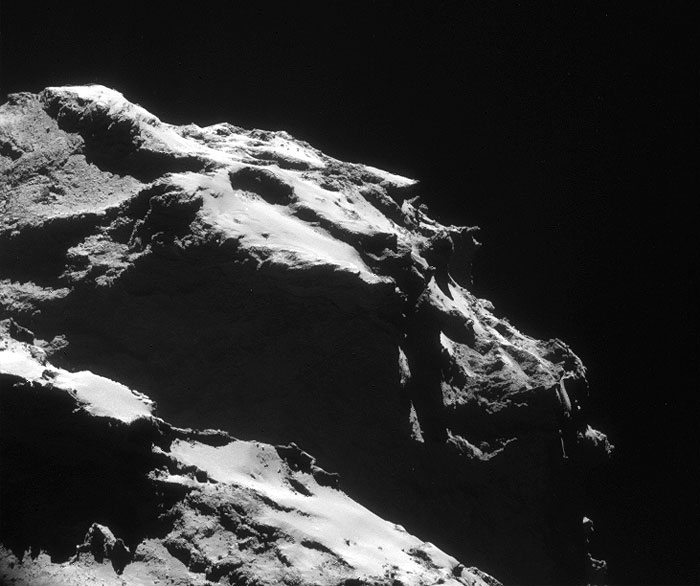
Quelle: ESA
-
Update: 6.02.2015
-
ANUKET VS. ANUBIS – COMETWATCH 31 JANUARY
This four-image mosaic comprises images taken from a distance of 28.0 km from the centre of Comet 67P/Churyumov-Gerasimenko on 31 January. The image resolution is 2.4 m/pixel and the individual 1024 x 1024 frames measure 2.4 km across. The mosaic has been slightly cropped, and it measures 4.6 x 4.3 km.
.

Four image mosaic comprising images taken on 31 January 2015 by Rosetta's Navigation Camera (NAVCAM). Rotation and translation of the comet during the imaging sequence make it difficult to create an accurate mosaic, and there may be some spurious spatial and intensity features as a result of the mosaic-making process, so always refer to the individual frames before performing any detailed comparison or drawing conclusions about any strange structures or low intensity extended emission. Credits: ESA/Rosetta/NAVCAM – CC BY-SA IGO 3.0
.
The scene provides a stunning view of both the comet’s larger lobe (bottom) and smaller lobe (top right). There is an interesting contrast between the rough appearance of Anuket, the region that starts on the smaller lobe and descends along the side of the comet's neck, and the smoother material of the Anubis region, visible on the larger lobe in this view, beneath the crags of Seth as seen on the upper edge of the lobe.
A prominent jet and other outflows are also portrayed in the image. The overall activity of 67P/C-G is evident in the way that the silhouette of the nucleus stands out against the faint glow of the comet’s coma, especially in the darkest regions (bottom left and far right).
The large number of small white blobs and streaks in the image are likely specks of dust or other small objects in the vicinity of the comet.
The four-image montage and the individual 1024 x 1024 frames are provided below:
.
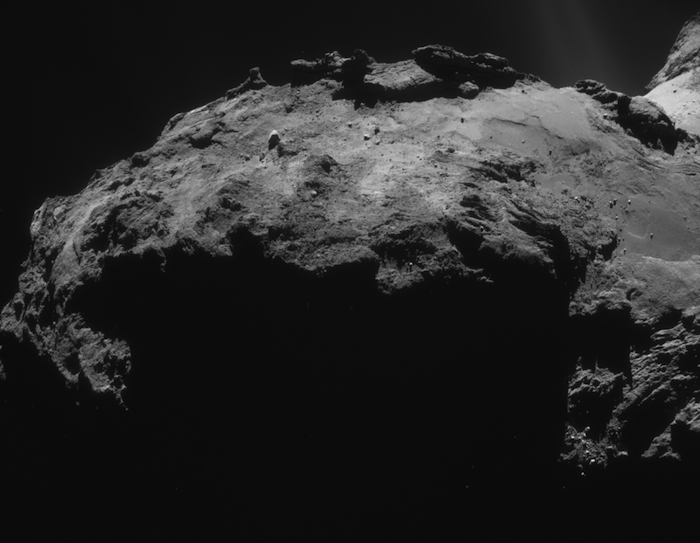
Quelle: ESA
.
Update: 9.02.2015
.
Churyumov-Gerasimenko: "Häutung" in der Glut des Südens

Bis zu 20 Meter seiner obersten Schicht könnte Komet Churyumov-Gerasimenko auf seiner bisher unbeleuchteten Südseite verlieren, wenn dort ab Mai 2015 die Sommerhitze herrscht. Die "Schlankheitskur", bei der der Komet Gas und Material seines Kerns ins All schleudert, wird durch die intensive Erwärmung bei der Annäherung an die Sonne ausgelöst. Die nördliche Hemisphäre hingegen verliert deutlich weniger, schätzen die Kometenforscher Dr. Horst Uwe Keller und Dr. Stefano Mottola vom Deutschen Zentrum für Luft- und Raumfahrt (DLR), die die mögliche Erosion von Churyumov-Gerasimenko aus Daten der OSIRIS-Kamera berechneten. Die Modellrechnung zeigt: Mit jeder seiner fast sechseinhalbjährigen Umlaufbahnen um die Sonne verliert der Komet gegenwärtig gewaltig an Oberfläche - und dies vor allem auf der Südseite, mit einem kurzen, aber sehr intensiven Sommer. "Der Komet häutet sich quasi ständig und zeigt frisches, unverbrauchtes Material an seiner Oberfläche, das noch nicht durch die kosmische Strahlung gealtert ist", sagt Dr. Ekkehard Kührt, der die wissenschaftlichen Beteiligungen des DLR an der Rosetta-Mission leitet.
.

Extreme Jahreszeiten im Laufe eines Orbits
Sechs Jahre und fünf Monate benötigt Komet Churyumov-Gerasimenko, um einmal um die Sonne zu kreisen. Dies macht er auf einer sehr elliptischen Bahn, die ihn über lange Zeit fern der Sonne reisen lässt - und ihn zurzeit zu seinem sonnennächsten Punkt im August 2015 führt. Dies und die starke Neigung seiner Rotationsachse um 53 Grad zur Bahn um die Sonne - die Erde ist im Vergleich dazu lediglich um 23 Grad geneigt - sorgen dafür, dass die Jahreszeiten auf den beiden Hemisphären sehr deutlich, aber extrem unterschiedlich ausgeprägt sind: Die nördliche Hemisphäre hat einen sehr langen, aber nicht besonders intensiven Sommer. Auf der südlichen Hemisphäre hält der Sommer jetzt erst Einzug - zwar nur für zehn Monate, aber durch die große Sonnennähe besonders intensiv. Orbiter Rosetta und Lander Philae haben dabei die beste Sicht auf den Kometen, der mehr und mehr zum Leben erwacht und Gas und Staub ins All stößt.
Um den Verlust an Kometenmaterial abzuschätzen, nutzten die OSIRIS-Wissenschaftler ein Oberflächenmodell des Kometen und unterteilten dieses in 100.000 kleine Dreiecke. So konnte berücksichtigt werden, dass es auch beschattete Flächen beispielsweise in Kraterstrukturen gibt oder die schroffen Bergwände die Sonnenstrahlung auf naheliegende Berghänge reflektieren und so verstärken. "Wir gehen in unserer Modellrechnung davon aus, dass das Wassereis in den aktiven Gebieten nur von einer sehr porösen, dünnen Staubschicht bedeckt ist", sagt DLR-Forscher Dr. Horst Uwe Keller. Zudem gehen die Forscher in ihrer Simulation davon aus, dass etwa vier Mal mehr Staub als Eis ins All geschleudert wird.
20 Meter verschwinden im All
Das Ergebnis: "Die Südseite, die zurzeit noch nicht von der Sonne angestrahlt und für die Wissenschaftler noch Neuland ist, wird in ihrem heißen Sommer bis zu 20 Meter ihrer obersten Schicht verlieren", sagt DLR-Forscher Dr. Stefano Mottola. "Auf der nördlichen Hemisphäre sieht das ganz anders aus: Dort werden bei einem Orbit um die Sonne nur die Bergspitzen und Klippen bis zu zehn Meter verlieren." Die bisher besonders aktive schmale Region zwischen den beiden größeren Kometenteilen ist nach den Berechnungen der Kometenforscher während des gesamten Orbits nur schwach beleuchtet und somit insgesamt nur mäßig aktiv.
Für Lander Philae ist der anstehende heiße Sommer von Vorteil: Er kann dann an seinem Standort nahe des Kometen-Äquators Energie tanken und wieder aus dem Winterschlaf aufwachen. Frühestens Ende März besteht die erste Möglichkeit, dass Philae sich meldet: Im Mai sind die Chancen am größten, dass das Lander Control Center des DLR wieder Kontakt mit Philae aufnehmen und ihn kommandieren kann.
Die Mission
Rosetta ist eine Mission der ESA mit Beiträgen von ihren Mitgliedsstaaten und der NASA. Rosettas Lander Philae wird von einem Konsortium unter der Leitung von DLR, MPS, CNES und ASI beigesteuert.
Quelle: DLR
.
Update: 10.02.2015
.
LAST WALTZ AT 28 KM – COMETWATCH 3 FEBRUARY
This four-image mosaic comprises images taken from a distance of 28.7 km from the centre of Comet 67P/Churyumov-Gerasimenko on 3 February. The image resolution is 2.4 m/pixel and the individual 1024 x 1024 frames measure 2.5 km across. The mosaic has been slightly cropped, and it measures 4.2 x 4.6 km.
These are the last images taken by Rosetta's NAVCAM before the spacecraft left its bound orbit around the comet at 28 km from the centre. On 4 February, Rosetta moved into a new operating phase characterised by a series of flybys past 67P/C-G at a range of distances, the first of which will be the very close encounter planned for next weekend, when Rosetta will pass just 6 km from the surface of the comet on 14 February.
.

Four image mosaic comprising images taken on 3 February 2015 by Rosetta's Navigation Camera (NAVCAM). Rotation and translation of the comet during the imaging sequence make it difficult to create an accurate mosaic, and there may be some spurious spatial and intensity features as a result of the mosaic-making sequence, so always refer to the individual frames before performing any detailed comparison or drawing conclusions about any strange structures or low intensity extended emission. Credits: ESA/Rosetta/NAVCAM – CC BY-SA IGO 3.0
.
In this orientation, we see the smaller of the two comet lobes in the upper part of the image, with the larger lobe below. Emerging from the shadows of the comet's neck are the cliffs of Hathor, in the central part of the image, crossing over to the Anuket region on the right. Parts of the smooth Hapi region on the neck are also visible in the shadows, just above the bright rim of the large lobe.
Some circular depressions on the Seth and Ash regions are visible on the large lobe; parts of the Anubis and Atum region can also be seen towards the lower right corner of the image.
The view of the small lobe shows mostly the Ma'at region, on the left, while the ridge on the right and the smooth plain above it belong to Serqet.
The four-image montage and the individual 1024 x 1024 frames are provided below:
.

.
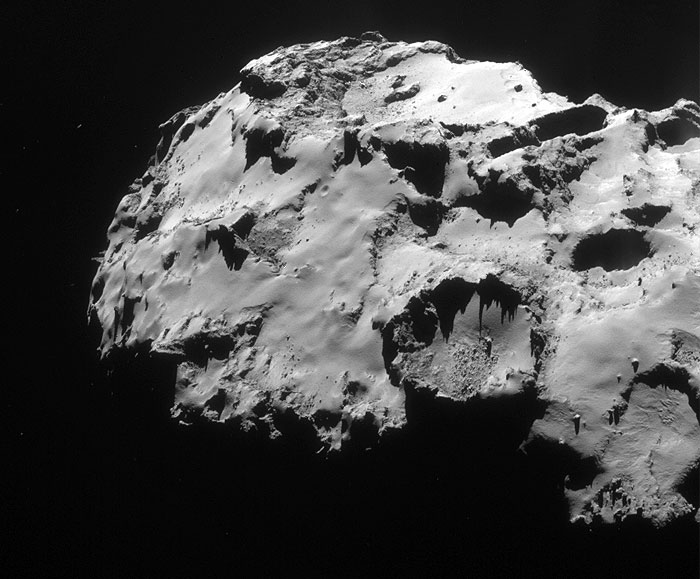
Quelle: ESA
-
Update: 12.02.2014
.
NEW PERSPECTIVES – COMETWATCH 6 FEBRUARY
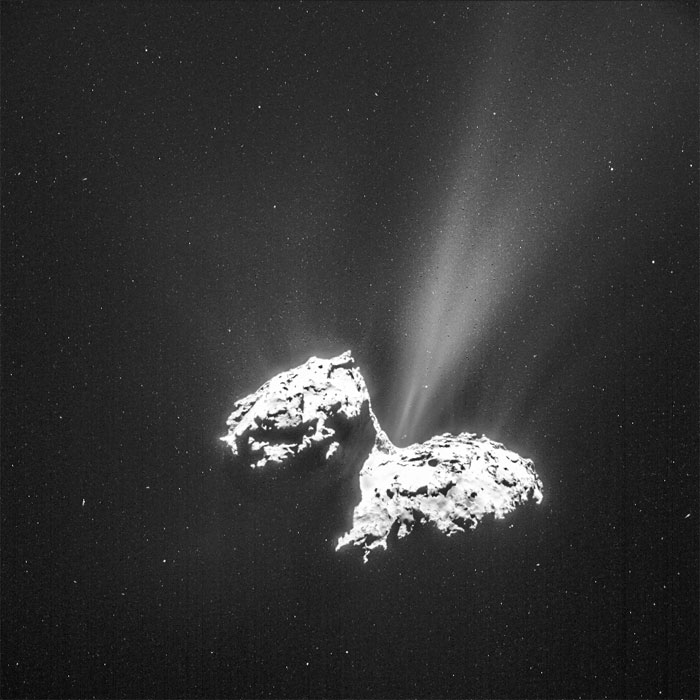
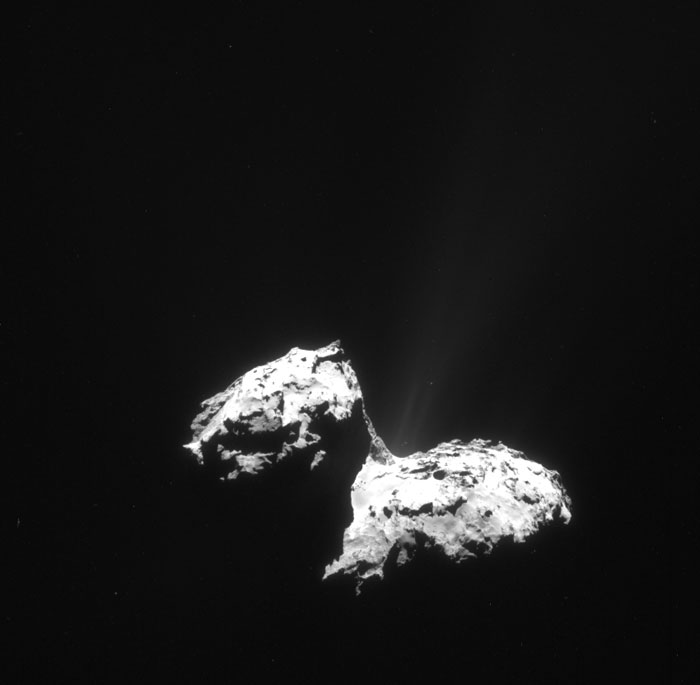
Today’s CometWatch entry presents the NAVCAM’s first single frame image capturing the entire comet nucleus since leaving bound orbits last week. The image was taken on 6 February from a distance of 124 km to the centre of Comet 67P/Churyumov-Gerasimenko. The 1024 x 1024 pixel image frame therefore has a resolution of 10.6 m/pixel and measures 10.8 km across.
.

NAVCAM image of Comet 67P/C-G taken on 6 February from a distance of 124 km to the comet centre. In this orientation, the small comet lobe is to the left of the image and the large lobe is to the right. The image has been processed to bring out the details of the comet’s activity. The exposure time of the image is 6 seconds. Credits: ESA/Rosetta/NAVCAM – CC BY-SA IGO 3.0
.
The image provides a stunning contrast to the recent close-up images, offering new perspectives on the extent of the comet’s activity. Indeed, the jets emanating from Hapi (the neck region) extend towards the edge of the frame in the upper right. Adjusting the intensity scaling, as we have done in this image, also emphasises the nebulous ‘glow’ of activity that appears to be coming from all over the sunlit surfaces of the nucleus. Bringing out the jets also highlights the large amount of background ‘noise’, which includes material ejected from the comet.
Today, 11 February, Rosetta is about 100 km from 67P/C-G and moving closer ahead of its 6 km flyby from the surface of the comet on Saturday – closest approach is at 12:41 GMT (13:41 CET). The NAVCAM is scheduled to take images 1-2 hours before and after closest approach, which will be downlinked to Earth Sunday/Monday.
The original 1024 x 1024 pixel image frame for today's entry is provided below:
.

Quelle: ESA
.
Update: 13.02.2015
.
Tschuri bekommt einen neuen Mantel
.

Tschuris flockige Staubteilchen ganz nah: Diese beiden Partikel sind einen halben, beziehungsweise 0,3 Millimeter groß.
.
Rosettas COSIMA-Instrument nimmt den Staubmantel ihres Zielkometen Tschuri unter die Lupe. Die dortigen Körnchen ähneln frappierend dem interplanetaren Staub.
Seitdem die Rosetta-Sonde im vergangenen August ihren Zielkometen Tschurjumow-Gerassimenko erreichte, hat sie rund 70 Prozent von dessen Oberfläche fotografiert. Die Bilder von „Tschuri“ zeigen eine Landschaft, die mal mehr und mal weniger von Staub bedeckt ist. Wie solche Staubpartikel unter dem Mikroskop aussehen, war bislang unbekannt. Nun präsentierten die Kometenforscher im angesehenen Wissenschaftsmagazin Nature Porträts und Analysen weitgehend unveränderter Partikel. Die Studie erfasst einen Zeitraum von August bis Oktober 2014, als Tschuri sich der Sonne von anfangs 535 Millionen Kilometern bis auf 450 Millionen Kilometer näherte. Rosetta war während dieser Zeit ihrem Kometen sehr nahe, sie umkreiste ihn meist nur in 30 Kilometern Abstand, oder sogar noch näher.
Kometen bestehen aus einem Gemisch aus Wassereis, gefrorenen Gasen, organischen chemische Verbindungen - und Staub. Welche Eigenschaften diese Mischung hat, soll neben zwei weiteren Bordinstrumenten COSIMA klären („Cometary Secondary Ion Mass Analyser“). Es wurde von einem internationalen Konsortium gebaut, geleitet vom Max-Planck-Institut für Extraterrestrische Physik in Garching. Jetzt ist das Göttinger Max-Planck-Institut für Sonnensystemforschung (MPS) für das Instrument zuständig. Die Hauptaufgabe von COSIMA liegt in der chemischen Analyse der Staubpartikel in Tschuris Staub- und Gashülle, der sogenannten Koma.
Um die Analyse-Einheit des Instruments genau auf die aufgefangenen mikroskopischen Körnchen auszurichten, verfügt COSIMA über eine Art Zieleinrichtung; diese schießt auch Fotos ihrer Studienobjekte. Beim langsamen Auftreffen der Partikel in COSIMAs Staubsammler, also bei Geschwindigkeiten von 1 bis 10 Metern pro Sekunde, sind die Teilchen nur geringeren Zerstörungskräften ausgesetzt. Bei früheren Experimenten, etwa an Bord der Stardust-Sonde der NASA, war dies anders. Dort prallten die Kometenkörnchen mit hohem Tempo auf.

Bereits im vergangenen August untersuchte COSIMA die ersten Körnchen. „Als Tschuri mit seiner Aktivität begann, stellten wir fest, dass seine Staubkörner 'flockig' waren. Sie enthielten kein Eis, aber eine Menge Natrium“, erläutert die Erstautorin der Studie, Rita Schulz vom ESTEC-Zentrum der Europäischen Weltraumbehörde im niederländischen Noordwijk. Solche flockigen Partikel haben viele Hohlräume und werden nur von schwachen Kräften zusammengehalten. Ohne Eis oder organische Substanzen fehle der „Klebstoff“, der die Partikel stabilisiert. Die Teilchen zerbersten, wenn sie auf der COSIMA-Staubsammelplatte auftreffen, entlang von „Sollbruchstellen“, so Schulz. Aus diesen Eigenschaften und aus dem Natriumgehalt schließen die Autoren, dass solche kometaren Körnchen die Quelle des Staubs sind, der verbreitet im Sonnensystem anzutreffen ist. Beispielsweise treten interplanetare Staubkörnchen als jährliche Meteorströme in Erscheinung, etwa der Perseiden-Strom im Juli bzw. August, der vom Kometen 109P/Swift-Tuttle stammt, oder die Leoniden (November), die auf den Kometen 55P/Temple-Tuttle zurückgehen. Schulz: „Wir haben das Material gefunden, aus dem die interplanetaren Staubkörner hervorgehen.“
Warum sind die aktuell vermessen Partikel eisfrei? „Wir gehen davon aus, dass die von COSIMA gesammelten flockigen Teilchen aus einer staubhaltigen Schicht des Kometen stammen, die sich seit Tschuris letzter Begegnung mit der Sonne auf der Kometenoberfläche gebildet hat“, erklärt der Chefwissenschaftler von COSIMA, Martin Hilchenbach vom MPS, der Co-Autor der Studie ist. Seitdem war dieser Staub jahrelang dem freien Weltraum ausgesetzt. Durch Sublimation sind das Eis und die gefrorenen Gase dem Staub verloren gegangen – er trocknete also aus. Hilchenbach: „Durch die zunehmende Aktivität des Kometen wird die trockene Schicht abgetragen. Wir erwarten, dass an der Oberfläche in den kommenden Monaten nun eine eishaltigere Schicht zum Vorschein kommt.“ Denn auf seinem 6,5 Jahre dauernden Orbit nähert sich Tschuri nun immer mehr der Sonne, bis er im kommenden August mit 186 Millionen Kilometern Abstand zwischen Mars- und Erdbahn seine geringste Sonnendistanz erreichen wird.
Live-Beobachtungen von Tschuris Aktivität
Dabei wird sich der Komet immer weiter erwärmen und sein Gasausstoß wird ansteigen. Die in den vergangenen Jahren ausgetrockneten Staubkörner werden von den Gasen mit in die Koma gerissen. Die Sonnenwärme wird so stark werden, dass nach und nach der gesamte alte Staub ins Weltall entweicht und frisches Material aus tieferen Bodenschichten die neue Oberfläche bildet. Schon jetzt ist der Wechsel hin zum neuen Mantel offenbar in vollem Gange, Schulz dazu: „Tatsächlich sollte mittlerweile viel von dem alten Staubmantel entfernt sein, bald schon werden wir Teilchen mit ganz anderen Eigenschaften untersuchen.“
Matt Taylor, Projektwissenschaftler der ESA-Mission erwartete ganz neue Einsichten beim Verständnis der Aktivität des Kometen: „Rosettas Staubmessungen nahe am Kometenkern sind ein wichtiger Baustein zur Verbindung zweier Ebenen kometarer Aktivität, die sich auf sehr unterschiedlichen Größenskalen abspielen: Diejenige der winzigen Staubkörnchen und die Ebene der großräumigen Vorgänge in Koma und Schweif, also dort wo Staub ins Weltall abgestoßen wird“, erklärt Taylor. „Mit Rosetta werden wir diese Prozesse in den kommenden Monaten live und aus der ersten Reihe studieren.“
Orginalveröffentlichung:

Das Experiment COSIMA wird vom Göttinger Max-Planck-Institut für Sonnensystemforschung geleitet.
.
COSIMA wurde von einem internationalen Konsortium entwickelt und gebaut, geleitet wurde dieses vom Max-Planck-Institut für Extraterrestrische Physik in Garching bei München. Das Experiment wird heute vom Max-Planck-Institut für Sonnensystemforschung in Göttingen geleitet. Darüber hinaus sind am COSIMA-Konsortium beteiligt: das Laboratoire de Physique et Chimie de l’Environnement von CNRS und der Université d’Orléans (Frankreich), das Institut d’Astrophysique Spatiale der Université Paris Sud (Orsay, Frankreich), das Finnish Meteorological Institute (Helsinki), die Universität Wuppertal, die von Hoerner und Sulger GmbH (Schwetzingen, Deutschland), die Universität der Bundeswehr (Neubiberg, Deutschland), das Forschungszentrum Seibersdorf (Seibersdorf, Österreich) und das Institut für Weltraumforschung der Österreichischen Akademie der Wissenschaften (Graz).
Quelle: ESA
-
Update: 23.45
.
LAST STOP BEFORE CLOSE FLYBY – COMETWATCH 9 FEBRUARY
Today’s CometWatch entry is a single frame NAVCAM image taken on 9 February from a distance of 105 km from the comet centre. The image resolution is 8.9 m/pixel; the processed image below has been slightly cropped to eliminate vignetting in the upper corners, and measures 8.5 x 8.5 km (the original, provided at the end of the post, measures 9.1 x 9.1 km).
.
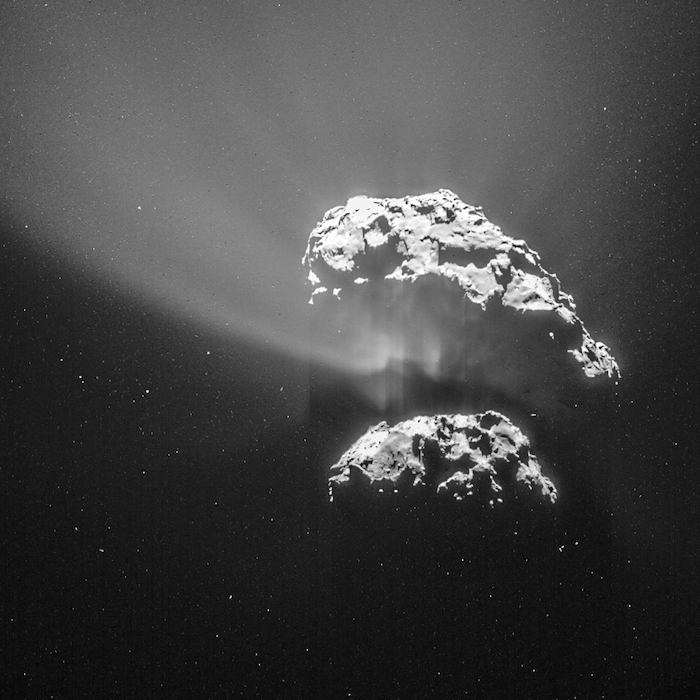
NAVCAM image taken on 9 February from a distance of 105 km from the comet centre. The exposure time is 6 seconds. Credits: ESA/Rosetta/NAVCAM – CC BY-SA IGO 3.0
In this orientation, the comet’s small lobe is the foreground and the large lobe is in the background. Particularly stunning is the delicate, ethereal glow of activity that contrasts against the shadowed region between the two lobes. From this viewing position the outflowing material seems to take the shape of a broader fan, rather than the more collimated jet-like features seen at other angles.
As seen in previous images, the sharp vertical shadows seem to be a result of the large lobe casting shadows down across the neck of the comet and towards the head. There is very little back-scatter illumination around the neck itself, but a diffuse ‘glow’ can be seen against these dark shadows where a broader ‘atmosphere’ is visible above the surface of the small lobe.
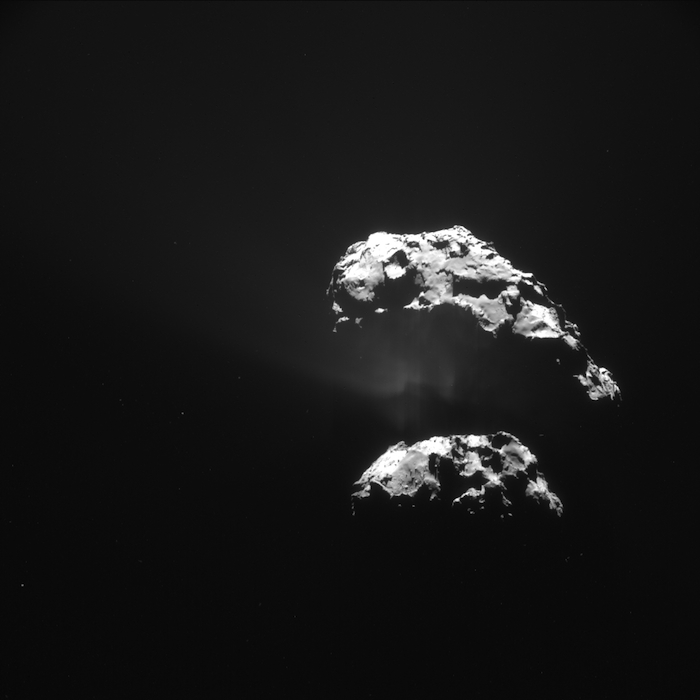

Rosetta is now less than 24 hours from its close 6 km flyby of the comet – closest approach tomorrow occurs at 12:41 GMT (13:41 CET) above the Imhotep region. The NAVCAM is scheduled to take images 1-2 hours before and after closest approach, when the spacecraft will be between about 8.5 and 11 km above the comet surface. These NAVCAM images will be downlinked to Earth Sunday/Monday and – depending on availability – we hope to be able to share one of these images with you as Monday’s CometWatch entry.
Meanwhile the OSIRIS team expects to get their images back some 5-12 days after the flyby, and therefore anticipate releasing an image within about two weeks of the event. The delay is due to data buildup in the spacecraft’s mass memory (which NAVCAM does not suffer from) and, furthermore, the bit rate is particularly low at the moment because of the relative position of Rosetta to the Earth – essentially on the opposite side of the Sun (you can check the situation with our Where is Rosetta? tool for today's date, for example).
Rosetta has ten other scientific experiments that will also collect data during the flyby. The spacecraft will also pass through a point where the Sun is directly behind the spacecraft, allowing the instruments to make unique observations of the comet surface and compare it with measurements made over a large range of illumination conditions. This will offer further insight into the physical properties and composition of the surface material, which in turn will help unravel the mechanisms that trigger cometary activity.
Indeed, the spacecraft will make valuable in-situ measurements of the inner coma, to sample the region where the comet’s coma is born. This will help scientists gain a better understanding of the exchange of momentum between the dust grains and gas molecules, testing mechanisms that have previously only been modelled theoretically.
Following the close flyby, Rosetta will move as far as 250 km from the nucleus. The trajectory also increases in inclination, to allow the instruments to take measurements over a large latitude range.
For more information about the close flyby, read our preview story: Rosetta swoops in for a close encounter
The original 1024 x 1024 frame for today’s CometWatch entry is provided below:
.

.
MISSION CONTROL AT CLOSEST APPROACH
Rosetta is preparing to make a close encounter with its comet tomorrow, on 14 February, passing just 6 km from the surface.
On 4 February, Rosetta began manoeuvring onto a series of new trajectories that will align the spacecraft for this week’s encounter. The series of thruster burns are happening (or have happened) as follows (distances are indicated from comet surface):
4 Feb – Depart from 26-km terminator orbit
7 Feb – Achieve 142 km from comet, then turn back
11 Feb – Arc back down to 101 km
14 Feb – Reach 50 km stand-off distance; turn and burn for the closest flyby arc
14 Feb – Conduct 6 km flyby at 12:40:50c GMT
The closest pass occurs over the comet’s larger lobe, above the Imhotep region (click on the image below to watch).
.

Rosetta's closest approach during 14 February flyby. Credits: ESA
Note that, in the main science phase, Rosetta’s trajectory is being set by the Rosetta Science Ground Segment (RSGS) at ESAC, on a 16-week planning calendar (known as the LTP – the ‘long term planning’ process), and is fully optimised for the suite of instruments on board.
This means that 16 weeks before the start of each LTP cycle, RSGS proposes a trajectory for that LTP. This trajectory is then checked, against spacecraft and mission constraints, among other factors, at ESOC by the flight dynamics team.
While closest approach on 14 February is certainly a significant event for science observations, for the flight control team at ESOC, it’s a fairly routine operation and just one more activity during the main science phase.
Very short week in, very short week out
Since the intense manoeuvring and operations of 2014, the flight control team have adopted a regular weekly planning cycle. This covers two ‘VSTPs’ (very short term plans) covering Wednesdays to Saturdays (planned on Mondays) and Saturdays to Wednesdays (planned on Thursdays). Specifically:
On planning days, last data inputs come in early in the morning – for optical navigation data, i.e. NavCam images, and radiometric data from the ground stations
Production of all flight dynamics commands needed for the upcoming VSTP and covering (among others) trajectory and pointing strategy for that VSTP
Merging of flight dynamics products with instrument commands and spacecraft platform commands
Making sure the merge is conflict free (reconcile instrument, spacecraft and mission constraints)
Generating, as output, not only commands to be uploaded to the spacecraft, but as well all data files needed on ground. These include, for example, the ground tracking station instructions for ESTRACK and NASA deep space stations for that VSTP, and the instructions for the automation tool in the ground control system.
Flybys – the new normal
For the rest of the current mission plan in 2015, in fact, Rosetta will always conduct flybys, and, based on predictions of increasing cometary activity, can no longer be manoeuvred so close to the comet as to be in a gravitationally bound orbit.
The net effect is that the workload for mission planning has settled into a more or less predictable, if still challenging, cycle. And, when not at work at ESOC during the week, the flight control team remain on call day/night/weekends.
Navigation: five times daily
The flight dynamics team at ESOC take optical images five times a day using Rosetta’s navigation camera, the NavCam. These images are then used in the optical navigation process to reconstruct the position and trajectory of Rosetta with respect to 67P.
“The NavCam is crucial for relative navigation and knowing where we are with respect to the comet,” says Rosetta Spacecraft Operations Manager Sylvain Lodiot.
He explains that a set of parallel trajectory plans are maintained; one set describing the ‘preferred’ case (making certain assumptions on comet activity), and the other describing the ‘high activity’ case (which is a fall back solution in case the preferred case can’t be flown, and is further from the comet). Also, the operations teams, with the approval of the mission manager, would command a transition to the high activity case if the optical navigation process were to fail for any reason.
Low bit-rate season
Beginning on 26 January, the comet and Rosetta entered conjunction season – a four-week period when both are orbiting more or less opposite Earth but on the other side of the Sun (see image below).
During ‘conjunction season’, the Sun interferes with the direct, line-of-sight radio signals transmitted between Earth and Rosetta.
“The practical effect is that data rates are reduced,” says Sylvain.
“Now, using ESA’s 35m Estrack stations, we get 14 kilobits per second, and this goes up to 45 kilobits per second when we use NASA’s 70m stations.”
This limitation regulates how much data can be downloaded in any one ground station pass.
By June, the orbital geometry will have improved with the spacecraft much closer to Earth, and data rates via ESA’s Estrack stations will then steadily recover to the maximum rate of 91 kbps.
The 2015 ‘routine’ challenge
The continuing challenge for operations in 2015 is to manage and reconcile all requirements, coordinate between the various specialists that support the mission, book tracking stations for the right times, keep an eye on spacecraft status and health and ensure that the science plan is implemented in the best possible way, while respecting all spacecraft constraints.
“For the flight control team and the supporting specialists at ESOC, like flight dynamics and Estrack stations, the operations workload has gone down significantly compared to the comet approach phase and the landing last year,” says Sylvain.
“Nonetheless, we can’t afford any less attention – it’s still a challenge and will remain so for the rest of the mission.”
Quelle: ESA
.
Update: 16.02.2015
,
COMETWATCH 14 FEBRUARY – FLYBY SPECIAL

Four-image montage of Comet 67P/Churyumov–Gerasimenko comprising images taken on 14 February 2015 during the first dedicated close flyby. This image set was taken at 4:32 GMT from a distance of 35.0 km. The image scale is 3.0 m/pixel and the montage measures about 6.1 km across.
Closest approach of about 6 km from the comet’s surface took place at 12:41 GMT.
.
On Saturday, Rosetta passed within just 6 km of the surface of Comet 67P/Churyumov-Gerasimenko in the first dedicated close flyby of the mission. The closest approach took place at 12:41 UT over the Imhotep region on the comet’s large lobe.
Four sets of NAVCAM images taken on 14 February were downlinked from the spacecraft yesterday and we are delighted to be able to share all four with you here today.
As usual, we present either a mosaic of montage of each image, noting that at the closest distances the combined effect of the rotation of the comet and the movement of the spacecraft between the first and last image being taken is particularly large, resulting in difficulties in creating an accurate mosaic. The montages/mosaics have been tweaked in Lightroom for global intensity/contrast, but we have not made any local adjustment of e.g. ghosts/vignetting or other local intensity mismatches. The individual frames are also provided here [as a zip file] to check features and to offer you the chance to create your own mosaics.
.
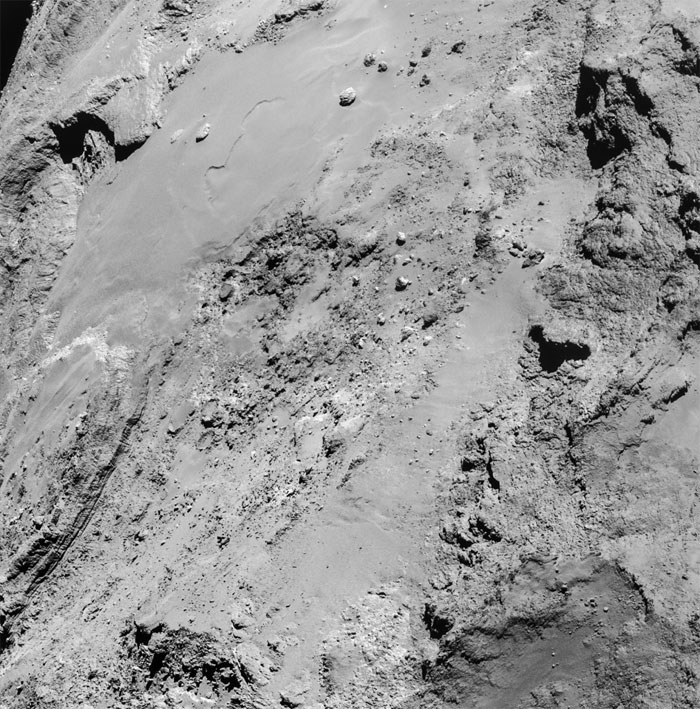
Four image mosaic of Comet 67P/Churyumov-Gerasimenko comprising images taken on 14 February at 14:15 GMT from a distance of 8.9 km from the surface. The image scale is 0.76 m/pixel and the mosaic measures 1.35×1.37 km across. The image focuses on the stunning features of the Imhotep region, on the comet’s large lobe.
Credits: ESA/Rosetta/NAVCAM – CC BY-SA IGO 3.0
.
The closest images, taken shortly before (right) and after (above) the point of closest approach respectively, provide stunning details of the contrasting terrains that we have seen so far on the comet. Particularly notable in the image set taken at 14:15 UT (above) is the long, layered and fractured exposed surface at the lower left.
Towards the centre of the frame the faint outline of raised near-circular objects with smooth floors can be seen. In the same image, several angular blocks appear to jut out from beneath the surface. Boulders, ranging in size from a few metres to a few tens of metres, lie scattered across the whole surface of the comet. Here, in Imhotep, we see boulder Cheops towards the top centre of the mosaic.
.

Four image montage of Comet 67P/Churyumov-Gerasimenko comprising images taken on 14 February 2015 at 10:15 GMT from a distance of 12.6 km from the comet centre (about 10.6 km from the surface). For the comet centre distance, the image scale is 1.1 m/pixel and each frame measures 1.1 km across. In this orientation the view is across the ‘back’ of the large comet lobe, with the ‘neck’ and the small comet lobe towards the top of the image.
Credits: ESA/Rosetta/NAVCAM – CC BY-SA IGO 3.0
.
During the flyby, the spacecraft passed through “zero phase” angle – i.e. with the Sun exactly behind the spacecraft – offering extremely good illumination conditions. As well as providing the opportunity to take close-up high-resolution images of the comet surface, flybys like this also allow Rosetta’s instruments to sample the innermost parts of the comet’s atmosphere, or coma, to better understand the connection between the source of the observed activity and the wider coma.
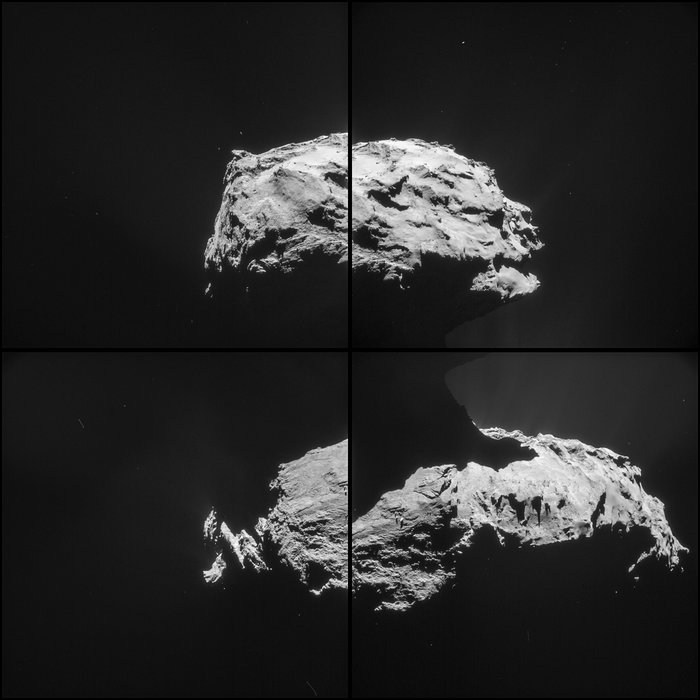
Rosetta is now moving out for a far view of the comet – it will reach a distance of about 255 km from the comet centre tomorrow.
.

Four image montage of Comet 67P/Churyumov-Gerasimenko comprising images taken on 14 February 2015 at 19:42 GMT from a distance of 31.6 km form the comet centre. The image scale is 2.7 m/pixel and each frame measures 2.8 km across. Rosetta’s parting shot following the close flyby features the comet’s small lobe at the top of the image, with the larger lobe in the lower portion of the image set.
Credits: ESA/Rosetta/NAVCAM – CC BY-SA IGO 3.0
Quelle: ESA
.
Update: 18.02.2015
.
AND AWAY AGAIN – COMETWATCH 15 FEBRUARY
After Rosetta's close flyby just 6 km from the surface of Comet 67P/Churyumov-Gerasimenko on 14 February, the spacecraft has once more moved away from the comet as part of its new phase of operations, reaching a distance of 255 km from the centre of 67P/C-G on 1
4750 Views
Created with page4
